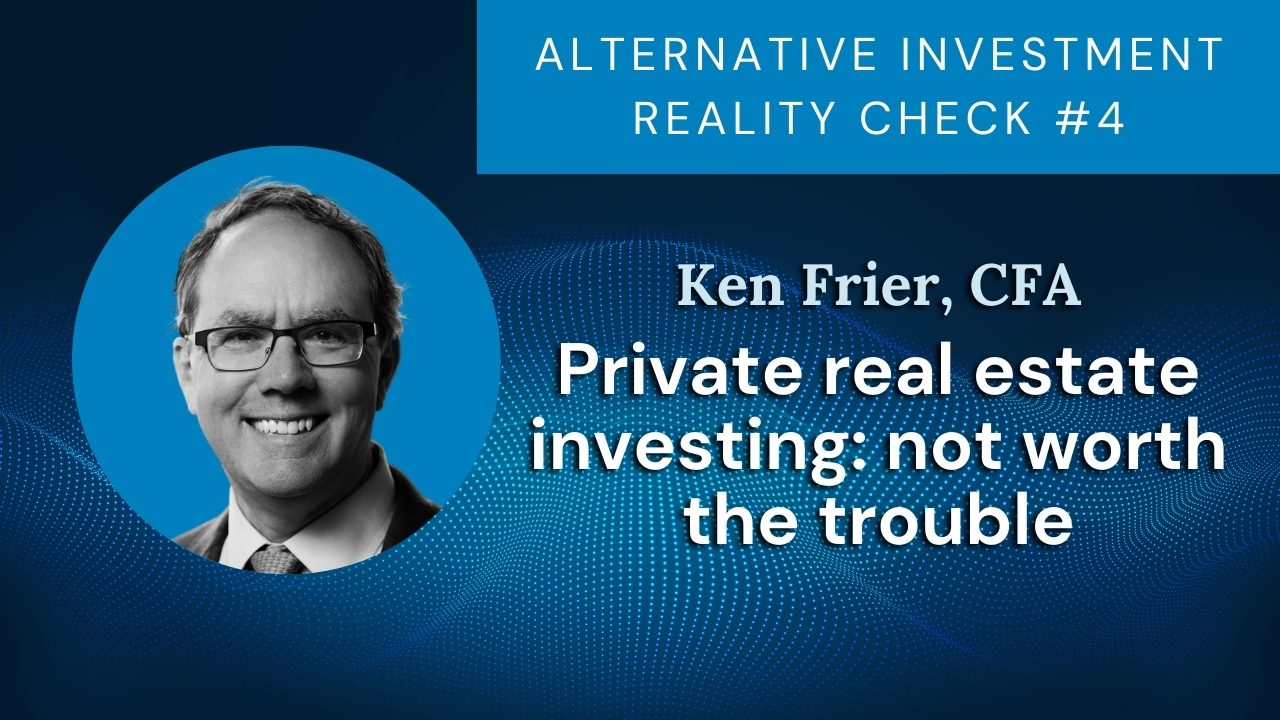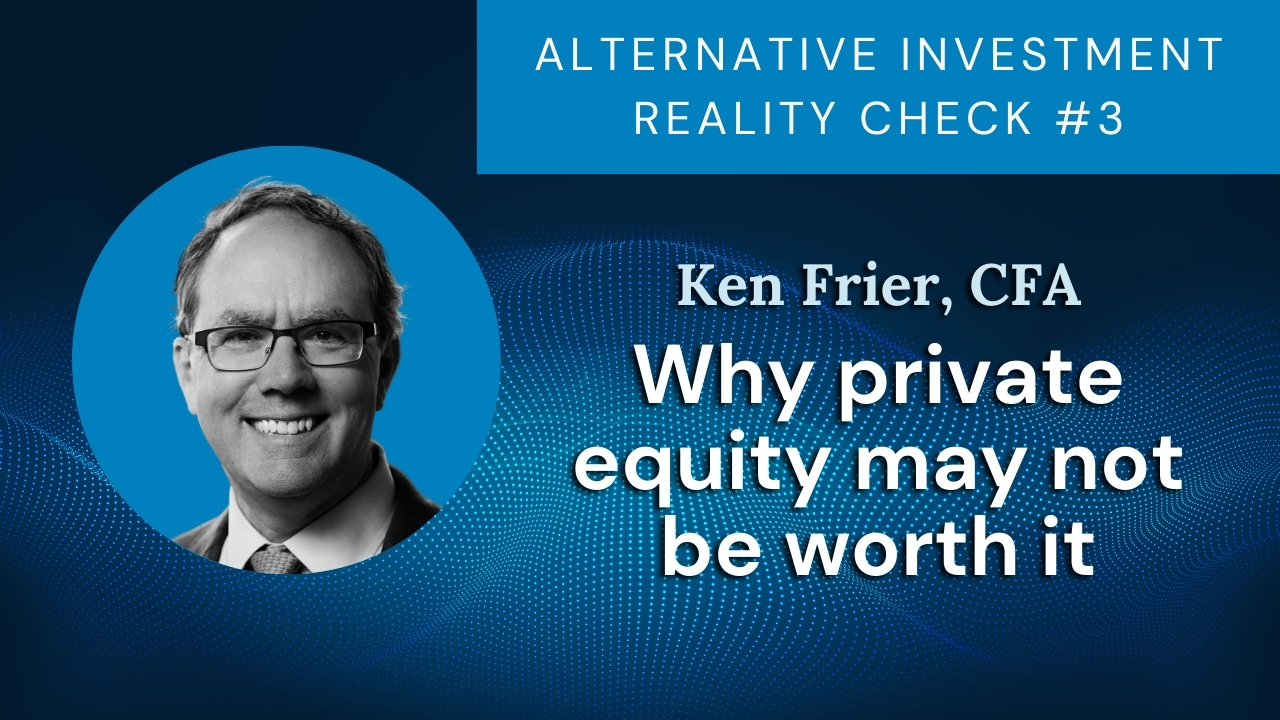In the past year, we’ve experienced a falling stock market with high volatility. For covered call investors, that’s about as good as it gets. Yet the benefit of covered calls vs. simply owning stocks without selling calls was modest. Moreover, covered call investors will likely lag the stock market by a large margin when the recovery from this bear market is underway. As we will discuss below, neither the short-term nor long-term prospects of covered call strategies are appealing. Therefore, investors should be wary about including these strategies in their investment portfolios.
About call options
A call option is the right to buy a security at a specific price on a specific date[1]. As an example of a call option, when Apple Computer stock was trading at $145 per share, an investor could have paid $6.50 per share for an option to buy Apple stock at $145 per share in one month. A month later, if the stock price was more than $145, the owner of the call would “exercise” the call, buying Apple at $145. If Apple stock was below $145 per share in a month, the investor would have spent $6.50 per share for no benefit. Call options may be sold as well. An investor could receive $6.50 per share in exchange for giving someone else the right to sell Apple stock to them at $145 in one month. The chart below shows the payoff in dollars per share from buying the call option and from selling the call option.
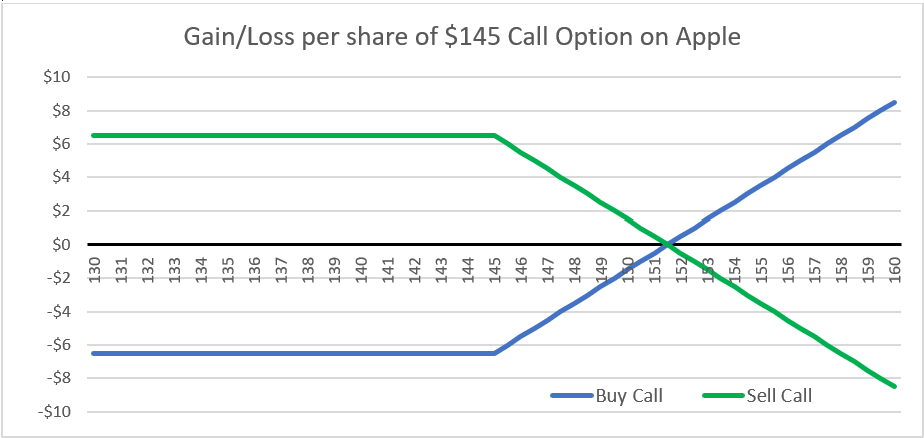
Covered call example
Suppose an investor owns 100 shares of Apple Computer (AAPL), trading at $145 per share, an investment of $14,500. The investor could sell 100 call options with an exercise price of $145 and an expiry date in one month. The investor would receive $6.50 per share or $650. The sold call options are “covered” because if Apple stock rises the losses from the call are covered by gains from the holding in Apple stock. The chart below shows the profit in one month from the 100 shares in Apple (blue), the sold call (green) and the combination, the covered call strategy (red).

The red line on the chart indicates why covered calls are seductive to investors. After a month goes by, if the stock is below $151.50 per share, the investor is better off with the covered call strategy (red line is above the blue line). That looks like a high probability of success – what’s the catch?
You will likely lose your position
In this example, the probability that Apple stock would be over $145 per share in a month and the call would be exercised is more than 50%. Even if the investor did not lose the Apple holding in month one, there is a near certainty that the holding would be called within a few months. If the investor holds Apple stock because they have optimism about the future of the company, or if they have a large unrealized gain on Apple which they don’t want to be taxed, then they would not want to be forced out of the position. After being forced out the investor could re-initiate the covered call position, buying Apple again and selling calls again, but many do not.
In a recent case, a client made a claim against Morgan Stanley related to being taken out of holdings by covered call positions. The client held positions in Apple, Nvidia, Tesla, Microsoft and other prominent growth companies. According to the client’s claim, Morgan Stanley advised covered calls on these holdings, and the calls were executed. The client’s positions in these stocks were called away and they missed out on most of the 2018 – 2021 boom in the stock prices of these companies. A panel of Financial Industry Regulatory Authority arbitrators awarded a $11.7 million judgment against Morgan Stanley on behalf of the client.[2]
You are “naked”
In this covered call example, an investor owns Apple Computer stock and has sold calls on that stock at $145. That covered call strategy is the exact same thing as a “naked put” strategy. In a “naked put” strategy an investor with no Apple stock position sells a one month put option on Apple with a strike price of $145 at $6.50 per share. The holder of the put has the option to sell 100 shares of Apple stock to the investor at $145. The gain or loss on the naked put is in the chart below. It is the same as the red “Apple + Call” line in the chart above. The put is “naked” (the opposite of “covered”) because the investor does not have a short position in Apple to cushion losses. Even though there is no difference between a “covered call” and a “naked put,” there seems to be a considerable psychological difference. “Covered calls” are regarded as relatively low risk, while “naked puts” are viewed as quite speculative.

You mainly benefit in bear markets
The Chicago Board Option Exchange has a BuyWrite index (the BXM index[3]) which can help us understand the long-term results of covered call strategies. The BXM index shows the outcome of buying the S&P 500 index (SPX) and writing a call on the index every month. The exercise price on the call option is the price of the S&P 500 at that time. This is like our Apple Computer example but in this case the underlying security is the S&P 500 index.
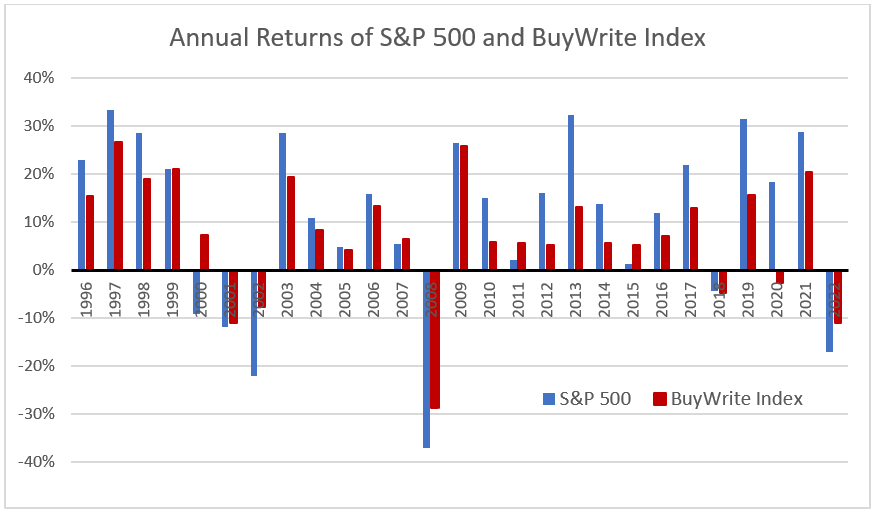
The chart above shows the annual returns for the S&P 500 index with and without covered calls in the 27 years from 1996 through 2022. We can see that covered calls (red columns) tend to have a better outcome than the index when the S&P 500 goes down. In 2022 through December 16 the S&P 500 is down 17% while the BuyWrite index is down 11%. The bear market years of 2000 – 2002 and 2008 were also ones in which covered calls had smaller losses than the S&P 500. The covered call strategy improves the return in bear markets because money is earned from selling the calls, and the call options are rarely called because prices are falling.
On the other hand, the covered call strategy can lag the underlying index considerably in bull markets. For instance, in 2021 the S&P 500 gained 28.7% while the BuyWrite index was up only 20.5%. In 2019 the S&P 500 was up 31.5%, with the covered call strategy up only 15.7%. In fact, in every year that the S&P 500 had a gain of 6% or more, it would have been better to simply own the index than to invest in covered calls. In the massive equity bull market from March 2009 to December 2021, an S&P 500 investor would have enjoyed a cumulative return of nearly 700%, while the covered call investor’s return was only 200%. The covered call strategy does poorly in bull markets because the sold calls limit the amount of potential gain to the investor.
You don’t do well on average
The next chart shows the cumulative return since the end of 1995 for the S&P 500 as compared to the BuyWrite index. The investor in the BuyWrite covered call strategy would have earned 6.6% per year, versus 9.2% per year for investors in the S&P 500. As the chart indicates, most of the gap between the outcome of the strategies occurred during the 2009 – 2021 bull market. An individual who executed the BuyWrite strategy at the end of 1995 would have enjoyed less than half the gain of the individual who simply owned the S&P 500 over the same period.
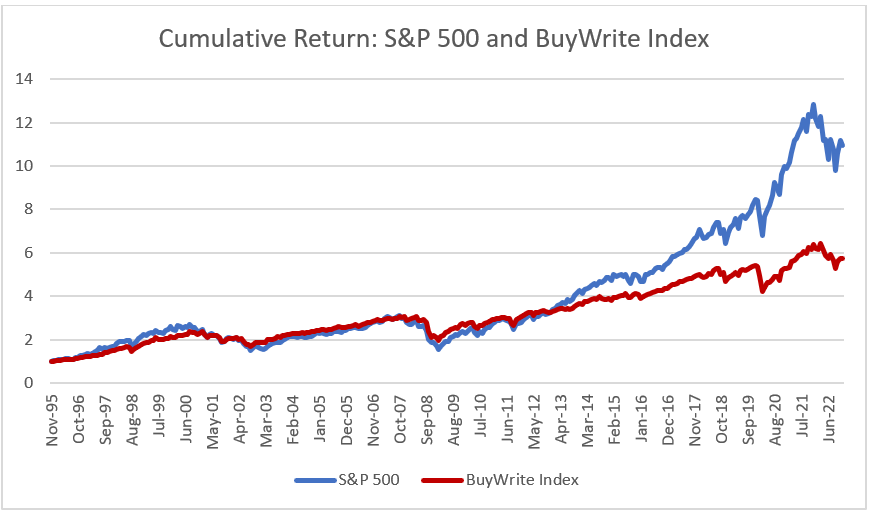
There may be adverse tax consequences
If the market moves higher and your underlying position gets ‘called away’ you will realize the capital gains or loss on that underlying position. If the underlying position already has an unrealized gain, any calls sold on the position would increase the likelihood of paying current taxes on the gain. It would usually be better to simply hold the underlying stock and let the gains continue to accumulate untaxed
The taxation of stock option transactions is intricate. Some types of options are a ‘Section 1256’ contract and some are not. The tax treatment can be affected by which is higher, the market price of the underlying or the exercise price of the option. Some options qualify for long-term capital gain treatment if held long enough, but others are always short-term no matter how long the position is held. Few tax advisors are well-versed in this topic, making this complexity another deterrent to investing in covered calls.
Summary
Because stocks fell in 2022, this was one of the infrequent years when a covered call strategy led to a better outcome than simply owning stocks without selling calls. If you are in a covered call strategy now, our advice is to stop doing so going forward. The long-term track record of covered call strategies is unfavorable. Moreover, when bear markets end, the stock market usually bounces back quickly. The average one-year gain from the bottom price in a bear market has been over 30%. If you wish to earn 30% instead of 15% in the market recovery, it will be best to simply be in the market rather than cap your potential gains with covered calls.
[1] The other type of stock option is a put option – the right to sell a security at a specific price on a specific date.
[2] https://www.advisorhub.com/morgan-stanley-ordered-to-pay-11-7m-after-covered-call-strategy-backfires
[3] Source Bloomberg, BXM index, data through December 16, 2022






